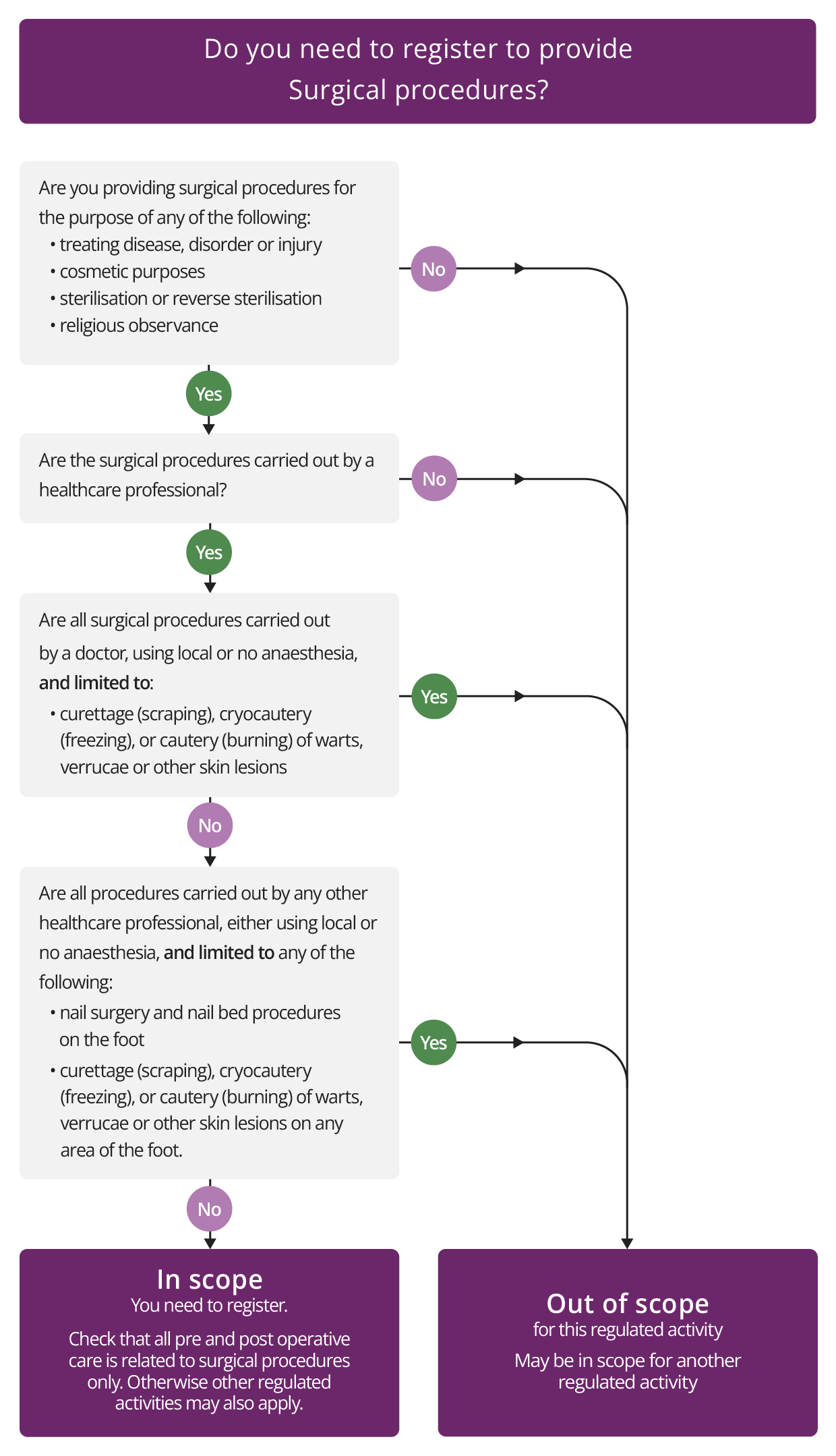Scope of registration
Surgical procedures
Description
This regulated activity covers the following procedures when carried out by a healthcare professional:
- Surgical procedures for the purpose of:
- treating disease, disorder or injury
- cosmetic surgery
- religious observance (for example, circumcision)
- sterilisation or reverse sterilisation.
The activity does not cover the following surgical procedures if they are carried out using local anaesthesia or no anaesthesia:
- nail surgery and nail bed procedures on the foot carried out by any healthcare professional
- curettage (scraping), cautery (burning) or cryocautery (freezing) of warts, verrucae or other skin lesions, carried out by:
- a medical practitioner, or
- another healthcare professional on any area of the foot.
Surgical egg retrieval
This regulated activity does not cover surgical egg retrieval carried out in connection with an activity listed in Schedule 2 of the Human Fertilisation and Embryology Act 1990 for which a licence has been granted under section 16 of that Act. This is because this procedure is carried out to assist a person to become pregnant, rather than to treat a disease, disorder of injury or reverse sterilisation.
Other procedures covered by Surgical procedures
If you provide surgical procedures, you will usually need to register for other regulated activities. For example, if you use imaging techniques during surgery you may need to register for the activity of Diagnostic and screening procedures.
Pre-operative and post-operative care
The regulated activity covers all pre-operative and post-operative care that is associated with the surgical procedures.
An example of pre-operative care might include assessment by an anaesthetist shortly in advance of the procedure (where this is to assess the patient’s suitability directly related to the procedure). It would not include an initial consultation with a surgeon before the procedures had been decided.
For post-operative care, the activity must be related to the procedure to be within the scope of the regulated activity. This will normally mean that it is planned to be related to the procedure. For example:
- post-anaesthetic care (recovery)
- follow-up in an intensive care unit
- care on a ward following surgery
Post-operative care may include a planned follow-up consultation after surgery, but would not include any further additional treatment (apart from checking on the procedures) that is decided in that follow-up consultation.
It also includes other treatment that is directly related to the surgical procedures and carried out under the surgical team. For example, if an anaesthetist temporarily changes a patient’s pre-existing prescription for medicines to avoid any conflict with anaesthetic drugs.
If the treatment goes beyond the surgical team, for example where the patient’s cardiologist changes a prescription – not the anaesthetist – then that is considered to be treatment in its own right rather than associated with the surgical procedures.
The key principles are that the activity must be:
- directly related to the surgical procedures, so only from the point at which the surgical procedures are decided on.
- only the planned pathway of care, not subsequent treatment.
- only within the surgical team, not the activity of other healthcare teams that may be taking place at the same time.
Surgical procedures carried out for religious reasons
Surgical procedures for religious reasons, such as circumcision, are only included where they are carried out by a healthcare professional. Where a healthcare professional carries out surgery for religious purposes they will be acting in their capacity as a healthcare professional rather than in a religious or spiritual role. This is because the code of practice for a registered healthcare professional prohibits them from disregarding the need to have appropriate skills, experience, equipment and facilities for this procedure and they cannot 'opt out' of their core duties and responsibilities as a registered healthcare professional, even if they are acting in a spiritual or religious role.
Cosmetic surgery
The regulations do not define cosmetic surgery, but the procedures that are within the scope of the regulated activity include those described as being:
- carried out by a healthcare professional for cosmetic purposes, where the procedure involves the use of instruments or equipment that are inserted into the body.
As an example, we consider liposuction involving the insertion of instruments into the body to be included in this activity. This is regardless of whether the liposuction is carried out using general or local anaesthesia, or whether the procedure involves the administration of a laser through a cannula inserted into the body.
A procedure such as the external application of ultrasonic energy without any incision or insertion of instruments into the body is not considered a surgical procedure.
The regulated activity of Surgical procedures does not include the following procedures:
- piercing
- tattooing
- subcutaneous injections to enhance appearance
- removal of hair or minor skin blemishes by application of heat using an electric current.
Hospices
A hospice should not normally be registered for the regulated activity of Surgical procedures.
This is because it is unlikely that a hospice would carry out surgical procedures apart from pleural taps and abdominal paracentesis. We consider these as treatment under the regulated activity of Treatment of disease, disorder or injury for the purpose of registration.
Check if you need to register for Surgical procedures
